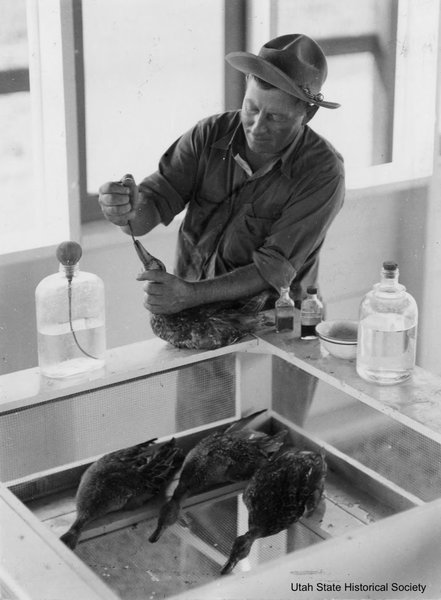Dublin Core
Title
Description
Humans and birds alike have long benefited from the desert oasis formed by the wetlands of Utah’s Great Salt Lake. The Northwest Band of Shoshone fished and hunted wildfowl there. Later, the duck clubs of Box Elder County -- which started in 1884 -- were among the first white settlers to appreciate the fragile landscape and wildlife of the marshes. Members of the duck clubs hunted birds for food, recreation, and the income generated from visiting hunters. But in 1910, dead birds lined the wetland shores of Great Salt Lake, and no one knew why.
In response to this mysterious affliction, duck clubs turned from recreation to activism. Because the illness threatened the very ecosystem that supported them, hunters campaigned to preserve the area. Local residents, sensing danger to their livelihood and heritage, joined the hunters in raising the alarm and ultimately generated a national response. Congress established the Bear River Migratory Bird Refuge in 1928 to conserve the wetlands at the mouth of the Bear River, and to study the cause and treatment of the outbreaks.
Once established, pioneering research by the scientists at the Refuge led to the discovery of avian botulism. Treatment was as simple as removing mildly sick birds to locations with fresh food and water. But scientists found that an ounce of prevention was worth a pound of cure. Since outbreaks tended to be large, prevention by stabilizing water levels worked better. The Refuge built earthworks such as dams, canals, and nearly 40 miles of earthen dikes in order to sustain healthy waterways. To this day, infrastructure at the Refuge helps manage water flow, keeping harmful bacteria in check.
Today, avian botulism continues to afflict waterfowl. Over 200 bird species use the nearly 80,000 acre Refuge as a rest stop in their yearly migration, and 67 species use the Refuge to nest. Increasing droughts and water-diversions threaten this system. Safeguarding these marshlands took the cooperation of duck hunters, scientists, and community members from all walks of life. Their legacy is ours to continue.
Creator
Source
_______________
See Brigham City Museum, exhibition file for Hometown Habitat: The History of the Bear River Migratory Bird Refuge, curated by Alana Blumenthal and Jennifer Hill, 2021; Jack Ray, Duck Fever: Hunting Clubs and the Preservation of Marshlands on the Great Salt Lake, Utah Historical Quarterly 87 no 1 (Winter 2019).

